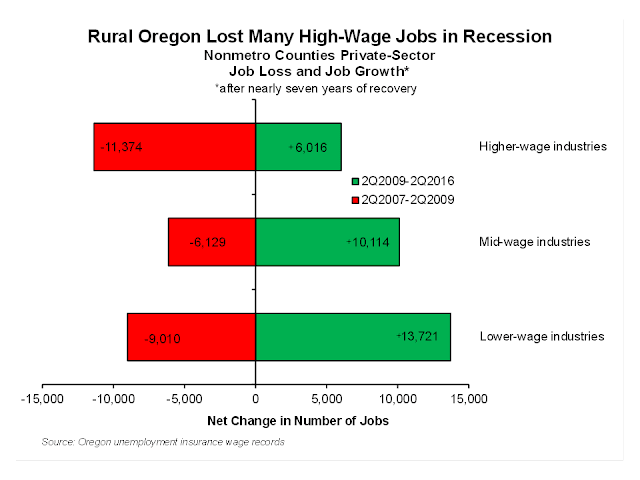First, a quick definition issue:
For this report, "rural Oregon" includes any county characterized as “nonmetropolitan” in federal data sources. Urban counties are those defined as part of a “metropolitan statistical area.” We selected this definition due to the breadth of information available at the county level. A shortcoming of this definition is that it undercounts the true impact of rural places. That's because areas inside metropolitan counties but outside city limits – such as Cave Junction, Florence, Vernonia, or Willamina – are included as urban here.
Altogether Oregon has 13 metropolitan counties and 23 nonmetropolitan or rural counties.
Oregon has been in a period of employment expansion since February 2010. In October 2014 statewide employment levels exceeded the pre-recession peak. However, in rural Oregon the recovery is ongoing. Today, employment remains 3.2 percent below the pre-recession peak in the combined rural counties, while metro counties as a group are solidly above their pre-recession peak employment. In order to fully recover from the recession, rural counties would need to add about 7,800 additional jobs, which would take another two years at the current pace of job growth. Twenty counties in Oregon remain below their pre-recession employment peak and 17 of them are rural counties.
In addition to having further to grow to reach pre-recession employment levels in some rural areas around the state, the jobs that have returned in nonmetro areas have more often been lower- and mid-wage jobs. Higher-wage jobs have yet to recover.
Between the second quarter of 2007 and the second quarter of 2009, Oregon’s rural counties lost almost 27,000 private-sector jobs. Rural Oregon’s high-wage industries – such as wood product manufacturing, specialty trade contractors, and forestry and logging – dropped more than 11,000 jobs in the Great Recession. Mid-wage industries dropped about 6,000 jobs in rural Oregon, and lower-wage industries lost 9,000 jobs.
For more information about rural Oregon, see our full report, or send questions my way!


No comments:
Post a Comment